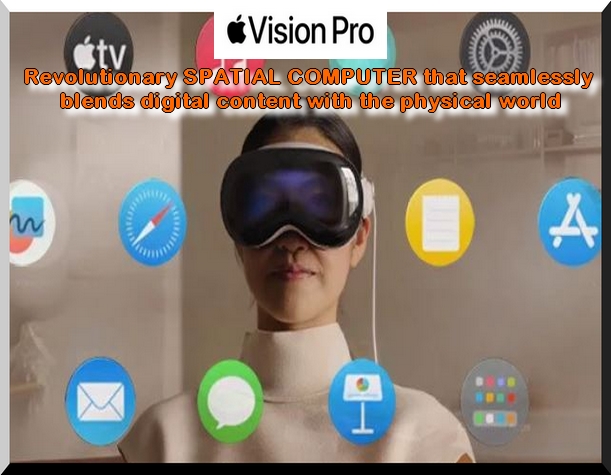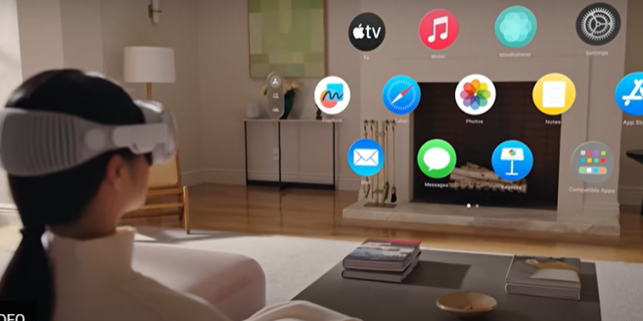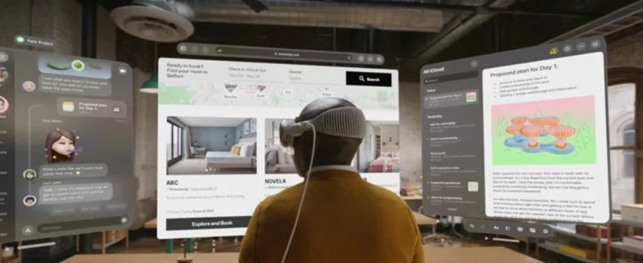Quanto c’è di innovativo nel nuovo visore VisualPRO di Apple?... rivoluzionerà davvero i mercati con il nuovo concetto di “Spatial Computer”?
-
Luigi Savio
- 07 Jun, 2023
- 06 Mins read

(ITALIANO)
Alla WWDC del 6 giugno 2023, Apple ha mostrato il suo ingresso nel mondo XR (Realtà Virtuale/Mista/Aumentata), presentando dopo alcuni anni di lavoro, preparazione e cura minuziosa, un visore pazzesco dalle caratteristiche che hanno dominato in questi due giorni la maggior parte dei canali comunicativi ICT (web/linkedin/youtube/ecc..): 23 Milion Pixel a disposizione sui due schermi ciascuno con risoluzione 4k, una corona fisica azionabile che dalla Realtà Mista ti isola completamente in quella Virtuale, potenza computazionale immensa grazie ai due chip M2 e R1 per garantire che ogni esperienza si svolga davanti ai nostri occhi realmente e con una vera percezione sonora 3D. Anche il design non è stato lasciato al caso, e il visore nella forma e nei materiali richiama alla mente il film di Steven Spielberg ‘Ready Player One’. Oltre ad altre funzionalità, sono previste cooperazioni con Disney per fruire contenuti 3D ready, per ottenere il massimo dell’immersività.

Come Iphone ha portato il web, il video e l’intrattenimento in unico dispositivo, il nuovo visore sembra voler puntare a portare all’interno di esso il modo in cui lavoriamo/socializziamo/impariamo/divertiamo in una nuova dimensione che viene definita “Spatial Computing” (ritenuta la quarta rivoluzione dopo l’avvento del pc, internet, mobile). Tutto questo ha quindi un **grande potenziale nel guidare i consumatori e le industrie **in nuovo tipo di elaborazione e fruizione che molti stimano, avverrà da qui ai prossimi 5 anni. Ma perché il visore Apple viene ritenuto un GameChanger e ha già riscosso popolarità e il desiderio di acquistarlo gia in molte persone (alla modica cifra di circa 3500$) rispetto ad altri visori (Meta, HTC, Microsoft, e altri che arriveranno) ?...

Microsoft ha lanciato gli Hoholens già 8 anni fa, creando la genesi che ha portato l’emersione dell’industria XR. La vecchia Facebook (ora Meta), tramite l’acquisizione di Oculus, è diventata il riferimento nei visori standalone per il gioco ed esperienze immersive in realtà virtuale in questi anni (Quest, Quest2, Quest PRO, ed a ottobre arriverà il nuovo Quest3). Altri visori (HTC Vive, il cinese Pico4) in questi anni hanno portato innovazione e nuovi headset dall’hardware sempre più all’avanguardia. Ma allora perché cosi tanto clamore per Apple? Ha introdotto qualcosa che ancora mancava o ha puntato su altro che i noti brand non avevano sfruttato? Come tutti i prodotti, specialmente lato informatico, è il mantenimento e le costanti novità lato software che tengono in vita i prodotti, la continua innovazione non deve fermarsi o entrare in standby (come in parte successo per gli hololens di Microsoft).
Il nuovo visore è qualcosa di veramente innovativo? Per lo più no, è molto simile a Quest Pro, con batteria esterna della durata di 2 ore, e un prezzo doppio. A prima vista… perché alcune cose su cui ha fatto attenzione Apple, lo rendono davvero innovativo e possono essere la “leva” del successo che potrà avere il VisualPRO:
Mette al centro l’esperienza Utenza (UX)
Sfrutta l’ecosistema Apple (molto diffuso)
Comunicazione e dettagli sono importati
UX: le persone generalmente sono pigre e “meno fanno è meglio è”, quale miglior soluzione se non focalizzare con gli occhi l’applicazione da aprire e con un pizzico delle dita, aprirla e interagire con mani e voce?.. il visore funziona così, non devi più puntare ed agire con un controller.

Ecosistema: i dati presenti sul cellulare (iphone) o sul pc (mac) saranno accessibili dal visore per lavorare/videochiamarsi, vedersi film e partite o editare dati che l’ecosistema permette di avere **catapultati nella realtà aumentata **magari seduti comodamente sul divano.

Comunicazione: il lancio non ha mostrato chissà quali applicazioni nuove, ma il punto è stato annunciare che con questo visore molto cool, di classe, all’avanguardia, che puoi continuare a essere produttivo o divertirti con qualcosa che già conosci e hai familiarità “applicazioni in 2D” che però ora puoi posizionare e ingrandire a piacere su schermi virtuali e non più fisici (questa non è immersività, ma un qualcosa che tutti conoscono già e che ora possono applicarla in un altro modo).

Come andrà, solo il tempo lo dirà.. ma sicuramente** l’impulso verso lo “spatial computing” (XR) ha beneficiato dell’ingresso di Apple** e in futuro nuove applicazioni, altri visori e nuovi mercati, in cui sfruttare XR, porteranno a una diffusione (probabilmente) sempre più grande negli anni avvenire.
(ENGLISH)
At WWDC on June 6, 2023, Apple showed its entry into the XR (Virtual/Mixed/Augmented Reality) world, presenting after several years of work, preparation and meticulous care, a crazy visor with features that have dominated most ICT communication channels (web/linkedin/youtube/etc. ): 23 Million Pixels available on the two screens each with 4k resolution, an operable physical crown that from Mixed Reality completely isolates you into Virtual Reality, immense processing power thanks to the two M2 and R1 chips to ensure that every experience unfolds in front of our eyes truly and with true 3D sound perception. Even the design has not been left to chance, and the visor in shape and materials is reminiscent of Steven Spielberg's film 'Ready Player One'. As well as other various features and cooperation with Disney to enjoy 3D content for maximum immersiveness.
Just as Iphone brought the web, video, and entertainment into one device, the new visor seems to aim to bring within it the way we work/socialize/learn/entertain into a new dimension that is referred to as "Spatial Computing" (believed to be the fourth revolution after the advent of the pc, internet, mobile). All of this therefore has great potential in driving consumers and industries into new kinds of computing and fruition that many estimate, will happen within the next 5 years. But why is the Apple visor considered a GameChanger and has already gained popularity and the desire to buy it in many people (at the modest price of about $3500) compared to other visors (Meta, HTC, Microsoft, and others to come) ?
Microsoft launched Hoholens as early as 8 years ago, creating the genesis that led to the emergence of the XR industry. The old Facebook (now Meta), through the acquisition of Oculus, became the reference in standalone visors for gaming and immersive virtual reality experiences (Quest, Quest2, and in October the new Quest3 will arrive). Other visors (HTC Vive, China's Pico4) in recent years have brought innovation and new headsets with increasingly cutting-edge hardware. But then why so much hype for Apple? Did it introduce something that was still missing or did it focus on something else that the well-known brands had not exploited? As with all products, especially on the IT side, it is the maintenance and constant innovations on the software side that keep the products alive, the continuous innovation should not stop or go into standby (as partly happened with Microsoft's hololens).
Is the new visor something truly innovative? Mostly no, it is very similar to Quest Pro, with external battery life of 2 hours, and twice the price. At first glance ... because a few things Apple has paid attention to make it truly innovative and may be the "lever" of the success the VisualPRO may have:
- It puts the User Experience (UX) at the center.
- It leverages Apple's ecosystem (which is widespread).
- Communication and details are important
UX: people generally are lazy and "the less they do the better," what better solution than to point with your eyes to the application to open and with a pinch of your fingers, open it and interact with your hands/voice?.. the viewer works this way, you no longer have to point with a controller.
Ecosystem: data on your phone (iphone) or pc (mac) will be accessible from the viewer to work/video call, watch movies and games or edit data that the ecosystem allows you to have catapulted into augmented reality maybe sitting comfortably on the couch.
Communication: the launch didn't show who knows what new applications, but the point was to announce that with this very cool, classy, cutting-edge visor, you can continue to be productive or have fun with something you already know and are familiar with-"2D applications" that you can, however, now place and zoom in at will on virtual screens and no longer physical ones (this is not immersiveness, but something everyone already knows and can now apply in another way).
How it will go, only time will tell ... but certainly the momentum toward "spatial computing" (XR) has benefited from Apple's entry and in the future new applications for this and other visors, new markets in which to take advantage of XR, will lead to ever greater deployment (probably) in the years to come.